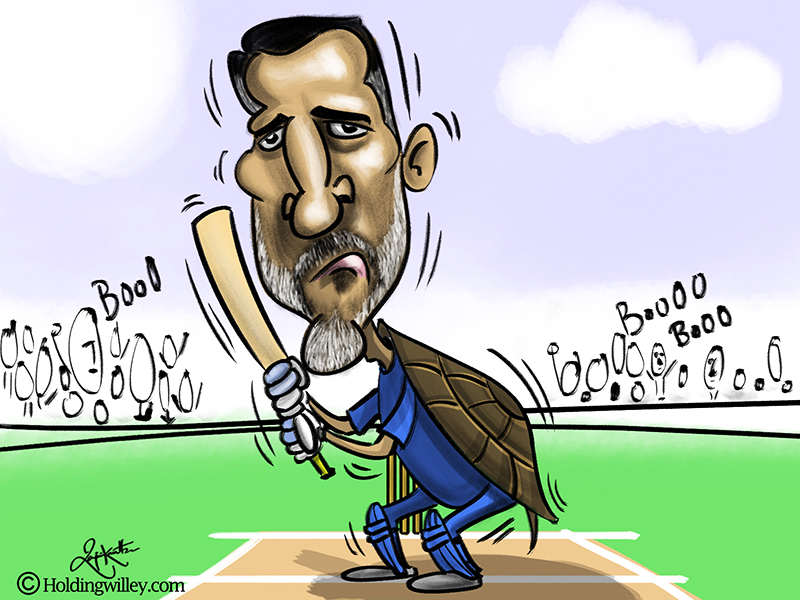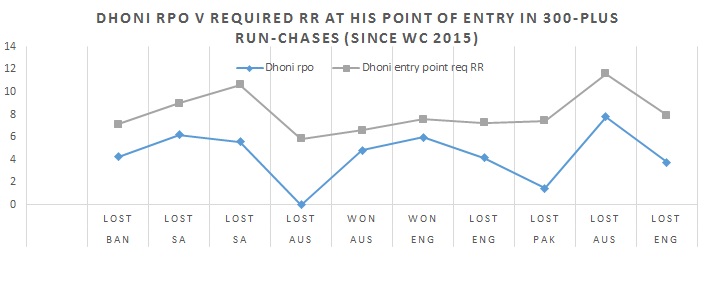 There is something about MS Dhoni that makes him the darling of one section of the crowd while irking another section at the same time. At Lord's, in the second ODI between England and India, the former Indian skipper was booed as he failed to get his scoring rate up in a steep run chase.
There is something about MS Dhoni that makes him the darling of one section of the crowd while irking another section at the same time. At Lord's, in the second ODI between England and India, the former Indian skipper was booed as he failed to get his scoring rate up in a steep run chase.
Dhoni seemed preoccupied with spending time at the crease and taking the game deep. What he probably did not realise was the kind of pressure it put on his teammates. Suresh Raina and Hardik Pandya departed while Dhoni continued to rely on his mantra.
The problem with his mantra is that if it does not come off, Dhoni can easily be seen as a villain who spoilt the chance to win the game. At Lord's it didn't come off. He kept watching wickets fall at the other end and eventually perished to a wild slog for 37 in 59 balls.
This approach didn't change in the series decider at Headingley, although this time he was required to rebuild the innings when batting first. Dhoni's prowess in run-chases is clearly etched in the memory of most fans. The most prominent one, of course, was the towering six off Nuwan Kulasekara to seal the 2011 World Cup final in Mumbai.
But times have changed. Team totals in the first innings have gone at least one notch higher in the last few years which means, more often than not, teams are left chasing mammoth scores in the second innings. The average first innings score in ODIs between the World Cups in 2011 and 2015 was 231 runs. That number has shot up to 243 since the 2015 World Cup.
Between 2011 and 2015, there were 78 first innings totals in excess of 300 with India contributing 13 of them. This leaves us with 65 totals in excess of 300 by teams other than India batting first. This number has shot up to 124 since the 2015 World Cup (including the World Cup). India have contributed to 14 of them, which means other teams have scored 300+ batting first on 110 occasions. There have been 420 matches in this time period, which means teams batting first have scored in excess of 300 close to 26% of the time, the greatest in the history of ODI cricket.
Now that we have established that the times have changed, we can go back to Dhoni and his ability to marshal a run chase. The wicketkeeper-batsman has a stunning average of 50.12 in the second innings of ODI matches. This is among the top 10 second innings averages in the history of ODI cricket (PS: Virat Kohli leads the list).
Even if this average is inflated by 46 not-outs, Dhoni's finishing prowess in run-chases until a few years ago was never in question. He has time and again let the game drift till the final few overs before grabbing it by the scruff of the neck and sealing the match.
In recent times, though, there has been a massive change, best exemplified by his inability to get going in run chases above 300. Since the 2015 World Cup, Dhoni has played in 10 ODIs where India have conceded over 300 in the first innings. In these matches, while chasing, Dhoni has scored 182 runs at a shoddy average of 18.2 with zero not-outs.
The much lauded finisher has no half-centuries in these games, with his highest score being 34. It is, however, imperative that we check his strike rates in these innings. In seven of the ten games, Dhoni has struck at a strike rate less than 100. Cut the number down to games where he has 15 or more runs and you see that he scored at a 100-plus strike rate in only one of them.

It is perhaps unfair to criticize Dhoni purely on the basis of strike rates. Team situations, required run rates etc. also play a major role in deciding a batsman’s strike rate.
In all of the 10 games, Dhoni has scored at a rate much lower than the required run rate, as the graph shows. Curiously, India lost eight of these ten games, showing that while they have been spectacular in ODIs in this time frame, the success is mostly based on either their bowlers bowling well in the first innings (restricting the opposition to totals less than 300) or their batsmen making big scores batting first.
Dhoni, meanwhile, has played in 24 run chases where the first innings totals have been less than 300, and averages 65 in these matches with 6 not-outs and three half-centuries. His overall strike rate of 70.70 in run-chases in this period tells a story in itself.
With another disappointing performance in the England series, Dhoni has once again raised questions about his approach in ODIs, and run-chases in particular.
Fast. Lite. Innovative. Shareable. Download our HW Cricket App, for Android and iOS!